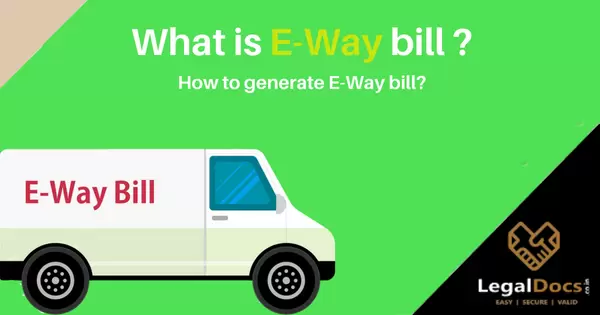What is E-way Bill?
E-way Bill :
The generation of the e-way bill has been made compulsory from 1st April 2018. With this new regime, the implementation of the Bill has been done in a phased manner, states have been divided into four lots to execute it further. It has replaced the Way Bill which was earlier a physical document and existed during the VAT regime for movement of the goods.
Electronic way bill commonly known as e-way Bill is a document electronically generated for specific movement of goods from one place to another. The movement of goods may either be inter-state i.e. within a state or intra-state i.e. within 2 or more states. Transport of goods of value more than INR 50,000 in a single invoice or bill or delivery challan in a vehicle cannot be made by a registered individual without an e-way bill. Post the generation of the e-way bill, a unique E-way Bill Number (also referred as EBN) is issued that is also made available to the supplier, recipient, and the transporter.
Reasons for generating e-way bill:
The government of India has implemented a uniform system across its states to ensure seamless movement of goods within the states and between the states. The mechanism was introduced by the government to capture the loopholes of the GST regime that resulted in tax evasions. The bill was introduced with the main aim to:
Provide hassle-free movement of goods all over the country.
Avoid separate transit pass in each state for the ease of movement of goods.
The policy shift from departmental-policy model to self-declaration one.
The system has brought about the changes in which invoices or challans are written to provide benefits, such as:
Taxpayers no longer visit the tax offices or check-posts for the generation of the e-way bill.
The check-posts have less or no waiting time. Thus ensuring faster movement of goods that optimize the use of vehicles and resources.
The e-way bill is a user-friendly system.
The system allows easy and quick generation of the bill.
It has smoothened the tax administration and the process has been simplified for easier verification of the e-way bill by tax officials.
Who should generate an e-way bill:
If an individual is GST registered:
Whenever a registered person gets involved in the movement of goods through self-owned or hired vehicle or by railways or by air or by ship. Either the registered person or the recipient generates the e-way bill in the Form GST EWB 01 through the electronic common portal by furnishing information in Part B.
Whenever a registered person causes the movement of goods such that the transporter is responsible for transportation by road, then it becomes the responsibility of the transporter to generate an e-way bill. In this case, the registered person will first furnish the information through Part B of the Form GST EWB. It is after this that the transporter will generate the e-way bill in accordance with the information provided by the registered person through Part A of Form GST EQB 01.
If an individual is not GST registered:
Whenever an unregistered person causes the movement of goods or consignment through a self-owned conveyance or a hired one, an e-way bill has to be generated. It may be generated through an unregistered person or by the transporter by filling Form GST EWB-01.
Whenever an unregistered person supplies the goods to a registered person such that the registered person knows the unregistered person, it can be considered that the registered person is responsible for moving the consignment. Therefore, it is the duty of the registered person or the transporter to complete the formalities of the e-way bill.
When should the e-way bill be issued
Ideally, an e-way bill should be generated before the commencement of movement of goods. It is generated for the goods which are valued more than INR 50000 on the invoice. The movement of goods will be either supply or return or due to an inward return from an unregistered person. For the purpose of generating an e-way bill, supply is considered as:
A payment in the course of business.
A payment which may not be in the course of the business.
There may be no consideration of payment in terms of supply, this means:
Sale of goods and payments made thereafter.
Branch transfers.
Barter or exchange where the payment is made by goods instead of money.
For all these types of movements, an e-way bill must be generated. However, for certain specified goods, even if the value of goods is less than INR 50000, the e-way bill needs to be generated. These movements of goods include:
Inter-state movement of goods that is done by the principal to the job Worker.
Inter-state movement of handicrafts that is done by a dealer who is exempted from GST Registration.
E-Way Bill Registration:
E-way bill can be generated from the GST E-way bill portal or SMS facility. However, before generating an e-way bill, the taxpayer will first have to register on the e-way bill portal. The documents required for e-way bill registration are:
GST registration certificate of the registered taxpayer or transporter.
A cell phone with a mobile number.
Once, the documents are ready, one may proceed for e-way bill registration and the facility is available for registered suppliers and the transporters with or without GST registrations.
How to Generate E-way Bill?
Single and consolidated options are available to generate e-way bills through the e-way bill portal. Besides this, one can change the vehicle number, cancel generate e-way bills and do many other things through this portal. There are two ways of generating e-way bill; on the web, and through the SMS. Here is a step by step generation process through the web-based method.
For the purpose of generating an e-way bill, it is required that one must:
Register on the E-way bill portal.
One must keep the invoice or the bill or the challan of the goods to be transported in hand.
In case the transport of goods is done through road, a transporter ID or vehicle number would be needed.
In case the goods are transported by means of rail, air or ship; transporter ID, transport document number, and the date of the document are required.
The diagram below will show a step by step approach in generating an e-way bill on the web-based portal:

The first step is to log in to the e-way bill system. With this one will have to enter the username, password, Captcha code. Once these details are entered, click on login to proceed.
Further, click on ‘Generate new’ option that is available under the ‘E-way bill’ heading that appears on the left-hand side of the dashboard.
The next step is to fill all the fields provided on the screen with relevant information. The information includes; transaction type, sub-type, document type, document number, document date, details of the item, and the transporter details.
In the end, click on the submit button. Once the system validates the data entered, the system will throw up an error if it occurs. Otherwise, the request will be processed and the e-way bill is generated in the Form EWB-01. Therefore, the unique 12 digit number is generated after this.
Once the bill is generated, it is required to print and carry the e-way bill for transporting the goods.
Responsibility and liability for the transporter in the E-way bill system:
The transporters carrying goods which may be by means of road, air, rail or ship need to generate e-way Bill. It becomes the responsibility of the transporter to generate an e-way bill if the supplier has failed to do so due to any reason. In case the transporter fails to do so, the transporter is liable to face a penalty of INR 10000 or the tax, whichever is greater that is sought to be evaded.
There is a process of verification of goods in transit that shall be recorded online by the officer-in-charge in Part A of GST EWB-03 within 24 hours of the inspection. The final report of the inspection has to be submitted in Part B of EWB-03 within 3 days of inspection. Goods have to inspected only once during the journey. Specific information on tax evasion is after an inspection is conducted. The vehicle has to be stopped again. In this regard, a transporter is given the privilege to upload the information if the vehicle is intercepted, stopped or detained for more than 30 minutes.
Are you looking for E-Way Bill in India?
Legaldocs will guide you in getting all necessary Documents and Registration required to get E-Way Bill in India, Please click on the following link to connect with our consultants.
Apply for E-Way Bill Knowledge Center
Knowledge Center


























LEAVE A REPLY: